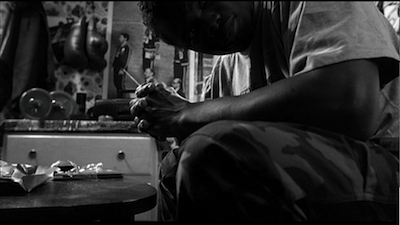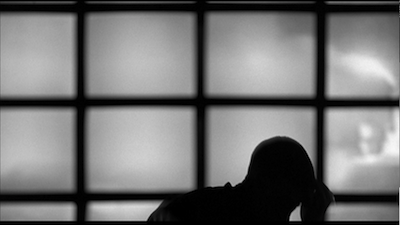
The 1995 French film La haine chronicles 24 hours in the life of a French ghetto the day after a good portion of its population rioted and looted in protest of police brutality against an Arab youth. The fires have mostly gone out, but tensions are still high. The cops are bruised and itching for payback, shop owners and others who had property damaged in the conflagration wonder what it was all for, and the rioters wait to hear if the victim will pull through in case they have to rise up again.

La Haine (Hate) was written and directed by Mathieu Kassovitz in response to an incident similar to the one he centers his film around--a personal tragedy in which a friend of his died in police custody. For the movie, he decided to turn his camera on a trio of friends who each represent a significant portion of those marginalized in France's projects (known as banlieue). The motormouthed schemer Saïd (Saïd Taghmaoui), the pensive boxer Hubert (Hubert Koundé), and the would-be gangsta Vinz (Vincent Cassel) are Arab, black, and Jewish, respectively. They are faced with institutionalized racism, leaving them with limited options and limited means. Culturally, they look outside France to America, and adopt the music and fashion of the hip-hop scene as expressions of their anger and frustration.

All three boys have something they want out of their day. Saïd wants to collect some money owed him, Hubert wants a way out of the wasteland, and Vinz wants to gain a reputation for himself. In a plot wrinkle right out of Kurosawa's Stray Dog, one of the riot cops lost his revolver in the melee, and Vinz is the one who found it. If Abdel, the boy in the coma, dies, Vinz will use the gun to kill a "pig," taking one of their ranks as retribution for the life they took. Vinz doesn't have any clear conception of a greater ideology. In fact, Kassovitz makes a running gag out of the confused philosophy that runs through modern culture. Expressed via jokes and anecdotes, most of the moral conundrums heard throughout La haine seemingly have no greater meaning. The only one that pays off is the one that opens the movie, the story of a falling man trying to maintain his optimism as he plummets to Earth. Hubert picks up this riddle. As the boxer who has decided he doesn't want to fight anymore, he can see the wisdom in its punchline: it's not about how you fall, it's about how well you land.
For an electrified 97 minutes, La haine follows these boys through their neighborhood, where they talk to their cohorts and tussle with local law enforcement, and then on a train to Paris. There, they become stranded for a night after Saïd's connection doesn't pay out. Killing time, they terrorize an art gallery, try to steal a car, and get in a brawl with some racist skinheads. Political indignation turns to "ghetto malaise," as the gallery owner phrases it. Not that a more harsh reality isn't always waiting for them; Hubert and Saïd also get a taste of actual police brutality. Fittingly, Vinz spends the same time they are in jail watching a violent movie. Like Jean-Paul Belmondo before him, this French gangster imagines himself as a rebel straight off the silver screen. Only now instead of worshiping Humphrey Bogart, our anti-hero looks up to Travis Bickle in Taxi Driver

Yet, it's not Scorsese that Kassovitz's incendiary masterpiece most resembles, it's Spike Lee's 1989 picture Do the Right Thing. Lee's film is the story of a day in the life of a New York neighborhood in the 24 hours leading up to a riot, not the period after. Both Do the Right Thing and La haine exist in a rarefied space, where there is seemingly no before or after, only now. Both trade elements of realism for abstraction in order to make their point, and both use an electrified visual style to give their parables life. Movement is important in these movies: the characters keep moving, and so does the camera. Kassovitz and director of photography Pierre Aïm borrow Ernest Dickerson's energetic use of all four corners of the image frame. They prowl around their scenes like an animal on the hunt, cajoling their characters into action by pushing in fast, rapidly removing the space between viewer and subject, leaving them nowhere else to go. Both films also use hiphop as the aural companion to the visuals. La haine replaces Mister Señor Love Daddy and Public Enemy with French DJ Cut Killer, who in one scene splices together KRS-One's "Sound of Da Police" with Edith Piaf and sends the music soaring out over his friends and neighbors.
Where Do the Right Thing and La haine differ significantly is in color palette. Whereas Lee and Dickerson cranked the color way up as a representation of the summer heat that was causing tempers to flare, Kassovitz and Aïm pull back. La haine is shot in black-and-white with occasional tinting--mostly hints of green and brown--a choice that suggests many things. For one, black-and-white is chillier in temperature, befitting a situation where everyone is trying to keep their cool. It also equalizes the characters, taking out the differences in color that they see in one another and having the audience gaze up them in a way that asks us to judge them for something besides their skin tone. By evoking the look of older films, it also suggests that racism and injustice is a problem as old as cinema itself. This creates an added layer of tension, as we assume at some point the color will explode all over the screen, its return all but inevitable.

I picked La haine for review because I wanted to see a young Vincent Cassel at work after having recently watched the two-part Mesrine biopic [review 1, review 2]. Nearly 15 years separate the two films, and Cassel was just as intense back then as he is now. Whereas Jacques Mesrine is all outward bombast buoyed by a sociopathic self-assurance, Vinz's posturing is undercut by his lack of confidence. The boy seethes with a rage that he's dying to express, but he doesn't understand it. Both Mesrine and Vinz will go off, but Mesrine unleashes knowing the full consequences of his attack; Vinz has no idea what is waiting for him. Cassel finds a sweet spot where he balances the teen's romantic visions of thug life with the blank wall he erects to prevent the outside world from teaching him anything.
Cassel is phenomenal in La haine, but it's unfair that he gets all the attention. The other actors in the ensemble are just as good, just as natural. I assume Kassovitz had them us their own names because it made them closer to their characters, and they definitely are believable in how they walk the walk. Saïd Taghmaoui in particular can also talk it. His tongue is rarely still, and he perhaps has the most important role in that he serves as the connective tissue between Vinz and Hubert. They each want to go in opposite directions--Vinz toward the blaze of hate, Hubert toward someplace more peaceful--but Saïd could go either way. The other two boys are caught in a cycle that is beyond their control, whereas Saïd is the one who can walk away a different person.

And he may also be the only one who can walk away. Kassovitz shows life in La haine as a constant circle. At one of the many points when Hubert is frustrated with Vinz, he tells him that had he not dropped out of school, Vinz would know that hate only breeds further hate. Knowledge of the disease is not the same as knowing what the cure is, however; Kassovitz's depiction of the world is such that there is no curbing the hatred. It's so deep in the system, there seems to be no way to shock ourselves out of it. Each death demands another death. If Abded dies, Vinz will have to kill a police officer, and so on. It connects back to one of the other stories told in the middle of the movie, about the man chasing a train with his pants undone. Every time he takes a hand off his waistband to grab onto the train, the pants fall and he trips. The train won't stop, he'll never catch it. When the boys ask what happened to him, the storyteller says he eventually froze to death.
The train keeps moving, and we're all out in the cold.


2 comments:
Hey Jamie, long-time reader, first time writing in with a minor correction. The song DJ Cut Killer splices with Edith Piaf is actually KRS-One's "Sound of Da Police", an equally incendiary song that hasn't achieved the immortality of "Fuck Da Police." Keep up the good work!
Thanks for the heads up, Mark. I didn't actually think it was NWA, but a cover of some kind--now I know why it sounded different.
Post a Comment